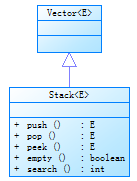Stack是一个后进先出(last in first out,LIFO)的堆栈,在Vector类的基础上扩展5个方法而来
Deque(双端队列)比起stack具有更好的完整性和一致性,应该被优先使用

1 E push(E item) 2 把项压入堆栈顶部。 3 E pop() 4 移除堆栈顶部的对象,并作为此函数的值返回该对象。 5 E peek() 6 查看堆栈顶部的对象,但不从堆栈中移除它。 7 boolean empty() 8 测试堆栈是否为空。 9 int search(Object o) 10 返回对象在堆栈中的位置,以 1 为基数。
Stack本身通过扩展Vector而来,而Vector本身是一个可增长的对象数组( a growable array of objects)那么这个数组的哪里作为Stack的栈顶,哪里作为Stack的栈底?
答案只能从源代码中寻找,jdk1.6
1 public class Stack<E> extends Vector<E> { 2 /** 3 * Creates an empty Stack. 4 */ 5 public Stack() { 6 } 7 8 /** 9 * Pushes an item onto the top of this stack. This has exactly 10 * the same effect as: 11 * <blockquote><pre> 12 * addElement(item)</pre></blockquote> 13 * 14 * @param item the item to be pushed onto this stack. 15 * @return the <code>item</code> argument. 16 * @see java.util.Vector#addElement 17 */ 18 public E push(E item) { 19 addElement(item); 20 21 return item; 22 } 23 24 /** 25 * Removes the object at the top of this stack and returns that 26 * object as the value of this function. 27 * 28 * @return The object at the top of this stack (the last item 29 * of the <tt>Vector</tt> object). 30 * @exception EmptyStackException if this stack is empty. 31 */ 32 public synchronized E pop() { 33 E obj; 34 int len = size(); 35 36 obj = peek(); 37 removeElementAt(len - 1); 38 39 return obj; 40 } 41 42 /** 43 * Looks at the object at the top of this stack without removing it 44 * from the stack. 45 * 46 * @return the object at the top of this stack (the last item 47 * of the <tt>Vector</tt> object). 48 * @exception EmptyStackException if this stack is empty. 49 */ 50 public synchronized E peek() { 51 int len = size(); 52 53 if (len == 0) 54 throw new EmptyStackException(); 55 return elementAt(len - 1); 56 } 57 58 /** 59 * Tests if this stack is empty. 60 * 61 * @return <code>true</code> if and only if this stack contains 62 * no items; <code>false</code> otherwise. 63 */ 64 public boolean empty() { 65 return size() == 0; 66 } 67 68 /** 69 * Returns the 1-based position where an object is on this stack. 70 * If the object <tt>o</tt> occurs as an item in this stack, this 71 * method returns the distance from the top of the stack of the 72 * occurrence nearest the top of the stack; the topmost item on the 73 * stack is considered to be at distance <tt>1</tt>. The <tt>equals</tt> 74 * method is used to compare <tt>o</tt> to the 75 * items in this stack. 76 * 77 * @param o the desired object. 78 * @return the 1-based position from the top of the stack where 79 * the object is located; the return value <code>-1</code> 80 * indicates that the object is not on the stack. 81 */ 82 public synchronized int search(Object o) { 83 int i = lastIndexOf(o); 84 85 if (i >= 0) { 86 return size() - i; 87 } 88 return -1; 89 } 90 91 /** use serialVersionUID from JDK 1.0.2 for interoperability */ 92 private static final long serialVersionUID = 1224463164541339165L; 93 }
通过peek()方法注释The object at the top of this stack (the last item of the Vector object,可以发现
数组(Vector)的最后一位即为Stack的栈顶
pop、peek以及search方法本身进行了同步
push方法调用了父类的addElement方法
empty方法调用了父类的size方法
Vector类为线程安全类
综上,Stack类为线程安全类(多个方法调用而产生的数据不一致问题属于原子性问题的范畴)
1 public class StackTest { 2 public static void main(String[] args) { 3 Stack<String> s = new Stack<String>(); 4 System.out.println("------isEmpty"); 5 System.out.println(s.isEmpty()); 6 System.out.println("------push"); 7 s.push("1"); 8 s.push("2"); 9 s.push("3"); 10 StackTest.t(s); 11 System.out.println("------pop"); 12 String str = s.pop(); 13 System.out.println(str); 14 StackTest.t(s); 15 System.out.println("------peek"); 16 str = s.peek(); 17 System.out.println(str); 18 StackTest.t(s); 19 System.out.println("------search"); 20 int i = s.search("2"); 21 System.out.println(i); 22 i = s.search("1"); 23 System.out.println(i); 24 i = s.search("none"); 25 System.out.println(i); 26 } 27 28 public static void t(Stack<String> s){ 29 System.out.println("iterator"); 30 Iterator<String> it = s.iterator(); 31 while(it.hasNext()){ 32 System.out.print(it.next()+" "); 33 } 34 System.out.println(" "); 35 } 36 }
结果:
1 ------isEmpty 2 true 3 ------push 4 iterator:1;2;3; 5 ------pop 6 3 --栈顶是数组最后一个 7 iterator:1;2; 8 ------peek 9 2 --pop取后删掉,peek只取不删 10 iterator:1;2; 11 ------search 12 1 --以1为基数,即栈顶为1 13 2 --和栈顶见的距离为2-1=1 14 -1 --不存在于栈中
Stack并不要求其中保存数据的唯一性,当Stack中有多个相同的item时,调用search方法,只返回与查找对象equal并且离栈顶最近的item与栈顶间距离(见源码中search方法说明)